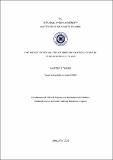Please use this identifier to cite or link to this item:
http://hdl.handle.net/11547/9391| Title: | THE IMPACT OF SOCIAL STRUCTURES ON POLITICAL CRISIS IN YEMEN FROM 2011 TO 2020 |
| Authors: | AMER, Yaser Yahya Mohammed |
| Keywords: | Yemen Yemeni Crisis |
| Issue Date: | 2021 |
| Abstract: | The Republic of Yemen was established shortly after the eruption of Yemeni Revolution on 26 September, 1962 against the Yemeni monarchy, which ruled Yemen for several centuries. The most recent one was the Mutawakil Kingdom led by Imam Ahmad Hamid Aldeen. After the revolution against Imam Ahmad Hamid Aldeen, Yemen entered a new phase in which five leaders took control over it: Alsallal, Aleryani, Alhamdi, Al-Ghashmi and Alarashi until 1978, and Ali Saleh who was elected as president of Yemen on July 17, 1978. Saleh was the military commander from Hashed tribe, one of Yemen's largest military-armed tribes. Saleh continued as a ruler for more than 33 years until the outbreak of the Youth Revolution or the Arab Spring revolution in Yemen in February 2011. He was overthrown later through a Gulf initiative presented by Saudi Arabia and other Gulf countries to solve the crisis in Yemen. After Saleh left power on February 27, 2012, Yemen witnessed a transitional phase. The Vice President Hadi was chosen as a president for a two-year transitional period. An inclusive national dialogue conference was held to solve the existing political problems in which all political components participated, including the Houthiss (who are also known as “Ansar Allah”, an armed religious group). It was agreed on the form of the state and the way to distribute wealth and power, but the Houthiss, with the help of former President Saleh and the tribes loyal to them, led an armed coup on September 21, 2014 and took control over the State institutions. The Houthiss expanded their control until they controlled the city of Aden in the far south of Yemen. Subsequently, an Arab coalition, formed and led by Saudi Arabia launched a war on Yemen on March 26, 2015 under the pretext of restoring legitimacy. As a result, the government was forced to exercise its duties in exile from the Kingdom of Saudi Arabia, because of which Yemen entered a new phase of conflict in which the political scene became more complicated. During this period, Yemen's political life has been characterized by many complexities as a result of the social connections that have affected political life. These complexities have emerged as a phenomenon more clearly than in other political societies in the Middle East. It can be said that the social structures connected with sectarian, tribal and regional factors and represented inputs that all produced a very complex political problem. Tribalism in northern Yemen, for example, was present and influential in the public policy of the state, in monopoly the leadership positions in the army, and in the basic functions of the state; while the regionalism was present in the south of Yemen in terms of dealing with northerners as occupiers. The problem was complicated when the religious and sectarian speech was employed in determining the course of politics. The doctrinal approaches in the Arab legacy, which limit power in a particular sect, established an ideological basis for a political problem existing until today. Hence, the researcher, who is in the process of understanding the impact of social structures on Yemeni political life, xi believes that the real understanding of the drives of political life requires understanding their social drives inherent in the structure of Yemeni society. According to that, the researcher chose the period from 2011 to 2020, as a time frame for the study, which witnessed the start of youth movement in the Arab Spring countries, that opened the way for subsequent developments that continue until now. |
| URI: | http://hdl.handle.net/11547/9391 |
| Appears in Collections: | Tezler -- Thesis |
Files in This Item:
| File | Description | Size | Format | |
|---|---|---|---|---|
| 10393732.pdf | 814.19 kB | Adobe PDF |  View/Open |
Items in DSpace are protected by copyright, with all rights reserved, unless otherwise indicated.
